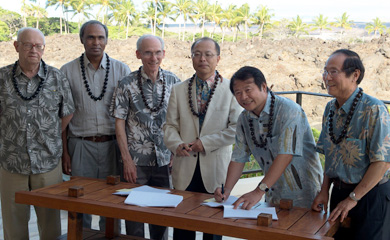Campus News
Scientific authorities sign TMT master agreement
The scientific authorities of the Thiry Meter Telescope partners have signed a master agreement defining the project goals and establishing a governance structure.

The Thirty Meter Telescope (TMT) project announced on Thursday, July 25, that all of the scientific authorities of the TMT partners have signed a master agreement. The master agreement document establishes a formal agreement amongst the international parties defining the project goals, establishing a governance structure and defining member party rights, obligations and benefits.
TMT is a unique and vibrant collaboration among universities in the United States with institutions in the nations of Canada, China, India and Japan, and with major funding from the Gordon and Betty Moore Foundation. Uniting these various parties under a master agreement stands as a significant accomplishment for TMT as a scientific endeavor with global reach.
“The signing of this master agreement marks a major milestone in the official commitment to and formalization of this global collaboration, ensuring that the TMT project is on schedule and progressing smoothly,” said Henry Yang, Chair of the TMT Collaborative Board. “We have been working towards this moment for a long time and this is a special day for astronomy’s next-generation observatory.”
The master agreement brings together the TMT partners for the purpose of developing, designing, financing, constructing, commissioning, operating and decommissioning a next-generation, thirty-meter-class astronomical observatory.
“In simple terms, the Hubble Space Telescope brought the universe ten times closer than existing ground telescopes in the 1970’s and 1980’s, and TMT will bring the universe twelve times closer than that,” said UCSC astronomer Sandra Faber, interim director of the University of California Observatories (UCO), which oversees UC’s participation in TMT.
“We are pleased with this vote of confidence from the scientific authorities,” said Edward Stone, vice chair of the TMT Board. “Their signing of this Master Agreement is a key endorsement of TMT’s scientific merits as well as the project’s overall implementation plan.”
Looking ahead, the next step will be for the financial authorities of the partners to similarly sign the document and finalize the funding plan.
“With the scientific authorities now all on board, we welcome and look forward to the critical support of the remaining financial authorities in advancing the TMT project,” said Yang.
2013 has been a busy and successful year for TMT, and the signing of the master agreement is a major step forward in the creation of a revolutionary astronomical facility. Construction of TMT is planned to begin in April 2014 and TMT is scheduled to begin scientific operations in 2022 on Mauna Kea, Hawaii.
Signatories of the Master Agreement:
The signatories of the Master Agreement are: Donald E. Brooks, Chair of the Association of Canadian Universities for Research in Astronomy (ACURA) Institutional Council; Jean-Lou Chameau, President of the California Institute of Technology; Masahiko Hayashi, Director General of the National Astronomical Observatory of Japan (NAOJ); Dr. P. Sreekumar, Director of the Indian Institute of Astrophysics; Jun Yan, Director General of the National Astronomical Observatories of China (NAOC) and Mark Yudof, President of the University of California.
About TMT:
TMT is the next-generation astronomical observatory that is scheduled to begin scientific operations in 2022 on Mauna Kea, Hawaii. TMT is a collaboration of the California Institute of Technology, University of California, the Association of Canadian Universities for Research in Astronomy, the National Astronomical Observatory of Japan, a consortium of Chinese institutions led by the National Astronomical Observatories of the Chinese Academy of Sciences, and institutions in India supported by the Department of Science and Technology of India. Major funding has been provided by the Gordon & Betty Moore Foundation. For more information, visit tmt.org , www.facebook.com/TMTHawaii or follow @TMTHawaii.